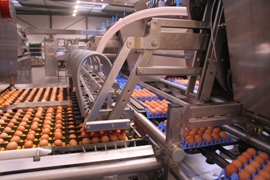Every egg counts

Professional egg packing stations use high capacity machines. After all, with quite often small margins, economy of scale is needed to make it a profitable business. The Moba Omnia is such a machine, handling up to 180,000 eggs per hour. Being very accurate and gentle it allows the maximum possible quality. Every step from infeed into the box counts. A difference of up to two percent more grade A eggs is possible. This can be the difference between profit or loss.
By Ad Bal
The Moba Omnia has been on the market for quite some years already and is used by customers all over the world. The modular type Omnia machine is found in packing stations who are handling eggs from external sources, or in large egg producing companies with their own egg handling facilities.
Here eggs are supplied directly from the layer houses.“Based on the experiences with Omnia over the years, the machine has been redesigned in various generations and fine-tuned time and time again”, says product manager Paul Buisman of Moba. “As a result, it now is a machine which is combining the highest possible output with the best possible egg quality. That’s where both producers and retailers are benefiting from.”
Customers who are using the most recent generation of the Omnia confirm that they are getting up to 2% more grade eggs into the final packs, often referred to as 2% more grade A eggs. That is quite something. “It may make the difference between sometimes even loss or good profit”, says Buisman. Enormous savings can be made if the number of cracks is minimised. Even eggs that are sensitive, like from older hens, may end up at the end customer without any cracks. This is a matter of handling them carefully and that is the secret of the Omnia.
Good balance needed
This success has to do with an accumulation of many apparently minor aspects”, Buisman continues. Every step counts and that makes the difference. This starts from the moment the eggs arrive in the grading and packing station, either on a conveyor belt from the layer houses, or in trays from external suppliers. Also a combination of both is possible. In the case of external supply, trays are unstacked and put on a plateau conveyor from which the suction grip heads of the loader will gently transfer them to the infeed conveyor. This goes in such a way that there is no difference in speed between the roll conveyor and the eggs themselves.
This success has to do with an accumulation of many apparently minor aspects”, Buisman continues. Every step counts and that makes the difference. This starts from the moment the eggs arrive in the grading and packing station, either on a conveyor belt from the layer houses, or in trays from external suppliers. Also a combination of both is possible. In the case of external supply, trays are unstacked and put on a plateau conveyor from which the suction grip heads of the loader will gently transfer them to the infeed conveyor. This goes in such a way that there is no difference in speed between the roll conveyor and the eggs themselves.
The construction of the grip heads allows handling of both small and large sized eggs. If the eggs arrive inline from the layer houses, they are evenly distributed on a conveyor from where they are guided into lanes. The speed of this conveyer is lower than of the so called accumulator which is the next step. Thanks to this principle, the eggs will touch each other only to a limited extent. Hardly any build up of eggs will occur, which otherwise would have been a major cause of collision and cracks. This is also thanks to the special shape of the partitions between the lanes. Yet sufficient supply is needed to keep the machine running. So a good balance between supply and infeed volumes is essential.
Individual handling
From the moment the eggs have arrived at the rollers of the infeed conveyor belt, the individual handling is a fact. Windows and Linux based software of the Omnia, precisely registers from which batch the eggs are coming and controls the eggs until the final destination in the pack. This can even be from various sources at the same time. Once at the rollers of the conveyor, every egg is monitored and registered individually, allowing very precise traceability. If demanded, optional visual pre-candling can be done in the accumulator area.
From the moment the eggs have arrived at the rollers of the infeed conveyor belt, the individual handling is a fact. Windows and Linux based software of the Omnia, precisely registers from which batch the eggs are coming and controls the eggs until the final destination in the pack. This can even be from various sources at the same time. Once at the rollers of the conveyor, every egg is monitored and registered individually, allowing very precise traceability. If demanded, optional visual pre-candling can be done in the accumulator area.
The special design of and distance between the rollers provides gentle transport to the transfer section. Prior to that stage, the eggs pass through the well known electronic crack detection module of Moba. Depending on the demands of the customer, also UV disinfection may take place in a special module. The shape of the rollers also provides easy cleaning. Optionally, a so called hygienic infeed conveyor is available, which has a set of two individual rollers for every egg. This avoids many eggs becoming dirty in the event of one leaking or broken egg.
Gently handing over
Then the moment of weighing and transfer is there. After the eggs are picked up by grippers, the grippers including the eggs are weighed. By doing so, the eggs are weighed individually without the need to roll over a weighing cell. “Also this is a step in the process of obtaining more grade A’s,” adds Buisman. “Compared to a system with weighing cells below the egg flow, there is less pollution which would make the weighing less accurate. And more accurate weighing means more room for optimising the output.”
After weighing, the eggs need to be placed in the main transport tracks of the machine in order to convey them to the packer lanes. This is done by a permanent movement of a set of transfer arms with egg holders. These are lifting the eggs to take them into the carriers of the main transport track. The arm construction is a technique whereby the maximum time is used to gently hand over the eggs from the holder into the carriers. Speeds of the transport track and the lifting arms exactly match, thus causing minimal impact to the egg. Depending on the model and related capacity, the Omnia can be equipped with various numbers of transport tracks. In these tracks, eggs may pass the optional inkjet or blood detection stations.
Running all the time
Then, in the final stage, depending on their weight and quality characteristics, the eggs drop from the carriers of the transport track into the packing lanes. Wherever possible in the process, sensitive equipment is positioned next or above the egg flow. This prevents broken or leaking eggs to cause pollution to the heart of the machine and thus disturbance of the process.
Then, in the final stage, depending on their weight and quality characteristics, the eggs drop from the carriers of the transport track into the packing lanes. Wherever possible in the process, sensitive equipment is positioned next or above the egg flow. This prevents broken or leaking eggs to cause pollution to the heart of the machine and thus disturbance of the process.
Many parts in the machine are made of industrial plastics and are very easy to remove. When a spare set of parts are used, the other set can be cleaned in the meantime. Thus the machine can keep running all the time.
Mission accomplished
Finally, when the eggs arrive in the packing lanes, they are placed in individual receiver sets. These are a kind of pockets that catch the eggs with an accuracy of about 1 mm. This accuracy assures exact positioning of the egg without touching another. Onwards, through similar sets of flexible and individual cups, the eggs end up in the box or carton that will be taken to the retailer. Mission accomplished. Here it eventually becomes clear to what extent grade A eggs have been obtained. And this is exactly showing Moba’s philosophy of individual egg handling throughout the entire packing process. The combination of gentle handling and smart software control ensures maximum efficiency and minimal losses.
Finally, when the eggs arrive in the packing lanes, they are placed in individual receiver sets. These are a kind of pockets that catch the eggs with an accuracy of about 1 mm. This accuracy assures exact positioning of the egg without touching another. Onwards, through similar sets of flexible and individual cups, the eggs end up in the box or carton that will be taken to the retailer. Mission accomplished. Here it eventually becomes clear to what extent grade A eggs have been obtained. And this is exactly showing Moba’s philosophy of individual egg handling throughout the entire packing process. The combination of gentle handling and smart software control ensures maximum efficiency and minimal losses.
“Customers of the newest Omnia range note the difference”, Buisman concludes. “They register that up to 2% more of the input ends up in the final packs. Fora major egg producer or packing station indeed that may be the difference between profit or loss.”
MORE INFORMATION













